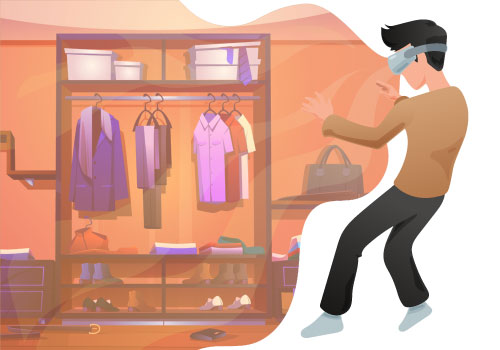Augmented Reality in fashion is the next big thing that will 360 change the way we shop online. Fashion is one of the biggest yet most challenging industries significantly affected by new trends like Augmented Reality technology and global economic uncertainty. The biggest challenges retailers face in the fashion industry are changing customer expectations and competitors embracing digital solutions to stay ahead.
Augmented Reality in fashion is one of the most significant technology trends that enhance the customer shopping experience, increase buyer confidence, boost conversions, and help businesses grow in the digital world. This guide will focus on how AR and fashion relate and why brands should adopt AR apps for their business.
ALSO READ: 6 Reasons Why Virtual Try-Ons Are a Need Of the Hour
Different Types Of AR Tech In Fashion
Fashion brands who want to create an immersive experience for their tech-savvy customers need to dabble in Augmented Reality technology and leverage the power of AR apps. According to a report by PwC, Augmented Reality and Virtual Reality will deliver a $1.5 trillion boost to the global economy by 2030. Here are a few different types of AR tech in the fashion industry that brands can use in the tech-driven world.
- Magic Mirrors
AR-enabled magic mirrors allow customers to visualize different garments on their bodies and check the right fit without trying them. Customers can stand in front of the AR-powered mirror and swipe through various clothing options to try clothes virtually. Besides clothing retailers, magic mirrors in the beauty industry can help customers try different shades of eyeshadow, blush, and lipstick to choose their perfect makeup look.
- Virtual Fitting Rooms
Many clothing brands have to deal with product fitting challenges that lead to high customer dissatisfaction rates and product returns. AR-equipped fitting rooms create an engaging and personalized experience for the users and enable them to try shoes and garments on their 3D avatar to see the correct product fit before they purchase the item.
- Virtual Try-On Technology
Unlike virtual fitting rooms installed in-store, users can try on a product on their body from their home with a camera-equipped device. Augmented Reality technology allows users to use their phones and see how different products, like makeup, jewelry, etc., will look on their faces and bodies.
SelfStylo is an AR-powered makeup virtual try-on tool that integrates with brand websites to create an immersive experience for users. Brands can incorporate AR virtual try-on apps on their website to embrace digital technology and improve user experience.
Benefits Of Augmented Reality in Fashion Industry
The advancement of digital technology in fashion enables brands to remove the hassle of customer shopping and helps them make informed purchase decisions. As a result, brands can leverage improved customer engagement, improve conversion rates, and boost loyalty. Below are the most significant benefits fashion brands can enjoy after implementing AR tech.
- Engagement
The more time customers spend in eCommerce stores, the higher the chances of making a purchase. This is because AR in fashion allows customers to browse through the different items in a fun and novel way, leading to improved engagement, increased product purchases, and repeat customers.
- Conversions
The average conversion rate for online fashion stores is less than brick-and-mortar shops, as customers find it hard to evaluate the post-sale satisfaction rate during online shopping. However, AR eliminates the risk of dissatisfaction rate by helping users interact virtually with the products and encouraging them to make a purchase.
- Returns
Reducing returns is the biggest challenge for eCommerce store owners, and AR try-on solution is the best way to help shoppers try on the product and eliminate the problem of poor product fit. When online shoppers try the product with AR technology before purchasing, it improves post-sale customer satisfaction and reduces the return rate.
- Loyalty
A fashion business must improve customer loyalty to sustain itself in the competitive market. Augmented Reality in fashion provides a reliable and smooth customer experience by addressing the customer’s pain points and boosting user loyalty.
- Personalization
Personalizing the user experience is vital to keep customers engaged with the business. Augmented Reality in fashion industry uses customer data to offer personalized product recommendations and help brands boost sales and generate high revenue.
As users spend more time on their smartphones and tablets, brands have started embracing the latest tools and technologies to make their business digital. Virtual try-on apps, social media AR filters, and magic mirrors are some of the best use cases of AR in a fashion that helps brands hedge against the competition.
ALSO READ: SelfStylo Launches New Augmented Reality Virtual Try-On For Makeup Brands
Get Ready For Augmented Reality In Fashion
Users reveal that AR technology helps them to make quick and informed purchases of clothing, shoes, makeup products, etc. Hence, it won’t be wrong to say that AR in fashion is no longer a matter of remaining competitive in the market; instead, it is a way to sustain business in the fast-moving fashion market.
Augmented Reality in fashion makeup apps such as SelfStylo is helping fashion brands to assist customers in choosing the right makeup products. Brands can integrate Augmented Reality technology or virtual try-on tool into their business to provide modern and personalized experiences to technology-driven customers.

